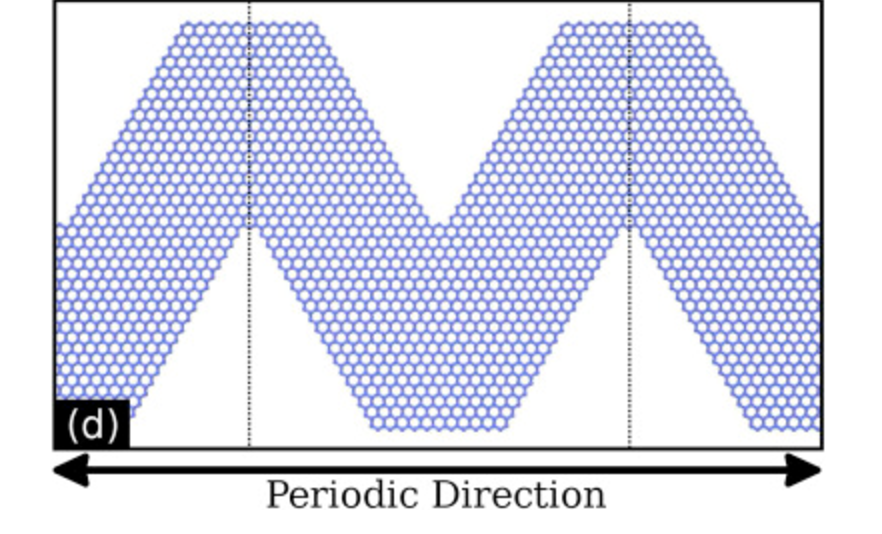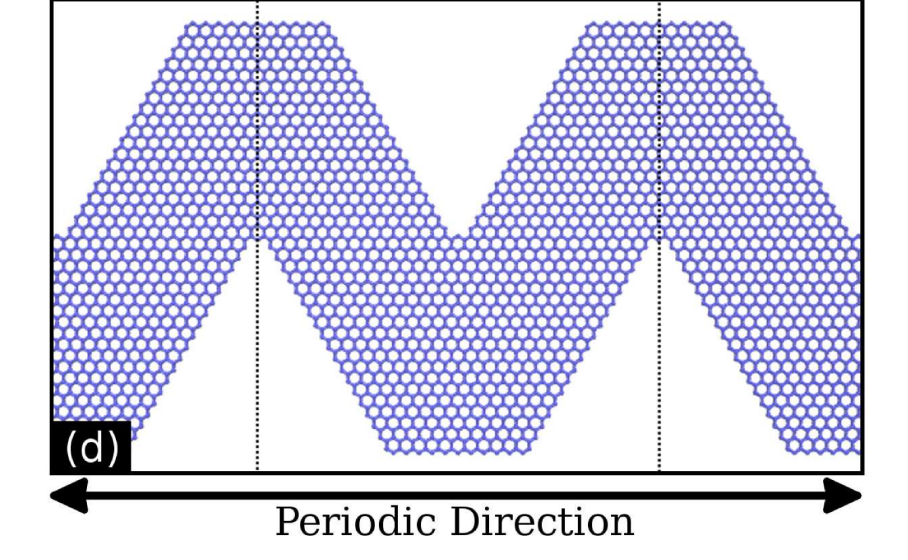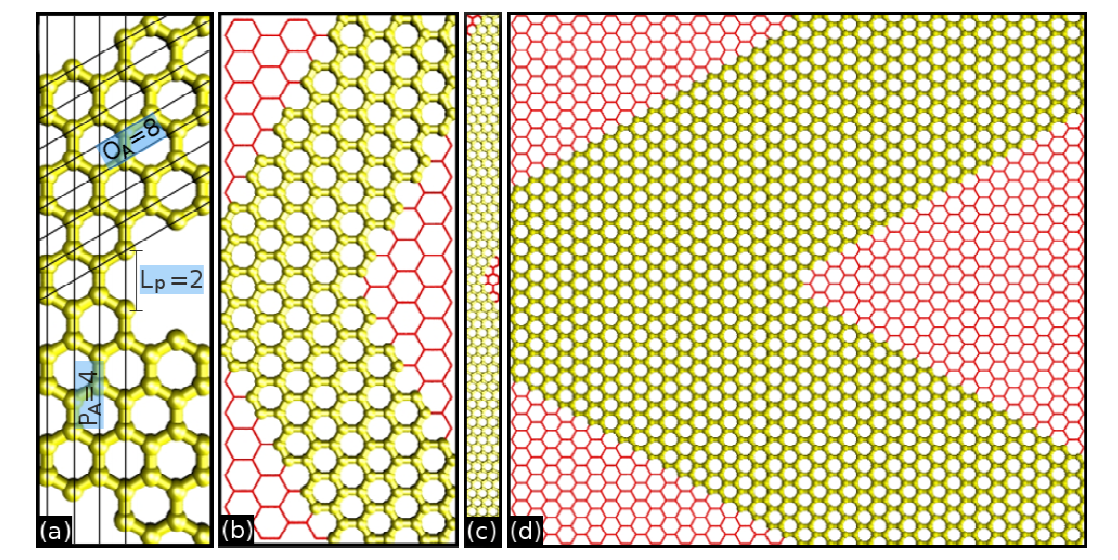Bizao, Rafael A; Botari, Tiago; Perim, Eric; Pugno, Nicola M; Galvao, Douglas S
Mechanical properties and fracture patterns of graphene (graphitic) nanowiggles Journal Article
In: Carbon, vol. 119, pp. 431-437, 2017, (See also ArxIv version: https://arxiv.org/abs/1702.01100).
@article{Bizao2017b,
title = {Mechanical properties and fracture patterns of graphene (graphitic) nanowiggles},
author = {Bizao, Rafael A and Botari, Tiago and Perim, Eric and Pugno, Nicola M and Galvao, Douglas S},
url = {http://www.sciencedirect.com/science/article/pii/S0008622317303743},
doi = {10.1016/j.carbon.2017.04.018},
year = {2017},
date = {2017-04-14},
journal = {Carbon},
volume = {119},
pages = {431-437},
abstract = {Graphene nanowiggles (GNW) are graphene-based nanostructures obtained by making alternated regular cuts in pristine graphene nanoribbons. GNW were recently synthesized and it was demonstrated that they exhibit tunable electronic and magnetic properties by just varying their shape. Here, we have investigated the mechanical properties and fracture patterns of a large number of GNW of different shapes and sizes using fully atomistic reactive molecular dynamics simulations. Our results show that the GNW mechanical properties are strongly dependent on its shape and size and, as a general trend narrow sheets have larger ultimate strength and Young's modulus than wide ones. The estimated Young's modulus values were found to be in a range of ≈100−1000 GPa and the ultimate strength in a range of ≈20−110 GPa, depending on GNW shape. Also, super-ductile behavior under strain was observed for some structures.},
note = {See also ArxIv version: https://arxiv.org/abs/1702.01100},
keywords = {},
pubstate = {published},
tppubtype = {article}
}
Bizao, Rafael A; Botari, Tiago; Perim, Eric; Pugno, Nicola M; Galvao, Douglas S
Mechanical Properties and Fracture Patterns of Graphene (Graphitic) Nanowiggles Online
2017, (preprint arXiv:1702.01100).
@online{Bizao2017,
title = {Mechanical Properties and Fracture Patterns of Graphene (Graphitic) Nanowiggles},
author = {Bizao, Rafael A and Botari, Tiago and Perim, Eric and Pugno, Nicola M and Galvao, Douglas S},
url = {https://arxiv.org/pdf/1702.01100.pdf},
year = {2017},
date = {2017-02-03},
abstract = {Graphene nanowiggles (GNW) are graphene-based nanostructures
obtained by making alternated regular cuts in pristine graphene nanoribbons.
GNW were recently synthesized and it was demonstrated that
they exhibit tunable electronic and magnetic properties by just varying
their shape. Here, we have investigated the mechanical properties and
fracture patterns of a large number of GNW of different shapes and
sizes using fully atomistic reactive molecular dynamics simulations.
Our results show that the GNW mechanical properties are strongly
dependent on its shape and size and, as a general trend narrow sheets
have larger ultimate strength and Young’s modulus than wide ones.
The estimated Young’s modulus values were found to be in a range of
≈ 100 − 1000 GPa and the ultimate strength in a range of ≈ 20 − 110
GPa, depending on GNW shape. Also, super-ductile behaviour under
strain was observed for some structures.},
note = {preprint arXiv:1702.01100},
keywords = {},
pubstate = {published},
tppubtype = {online}
}
obtained by making alternated regular cuts in pristine graphene nanoribbons.
GNW were recently synthesized and it was demonstrated that
they exhibit tunable electronic and magnetic properties by just varying
their shape. Here, we have investigated the mechanical properties and
fracture patterns of a large number of GNW of different shapes and
sizes using fully atomistic reactive molecular dynamics simulations.
Our results show that the GNW mechanical properties are strongly
dependent on its shape and size and, as a general trend narrow sheets
have larger ultimate strength and Young’s modulus than wide ones.
The estimated Young’s modulus values were found to be in a range of
≈ 100 − 1000 GPa and the ultimate strength in a range of ≈ 20 − 110
GPa, depending on GNW shape. Also, super-ductile behaviour under
strain was observed for some structures.
Bizao, RA; Botari, T; Galvao, DS
Mechanical Properties of Graphene Nanowiggles Proceedings
Cambridge University Press, vol. 1658, 2014.
@proceedings{bizao2014mechanical,
title = {Mechanical Properties of Graphene Nanowiggles},
author = {Bizao, RA and Botari, T and Galvao, DS},
url = {http://journals.cambridge.org/action/displayAbstract?fromPage=online&aid=9248042&fileId=S1946427414004023},
year = {2014},
date = {2014-01-01},
journal = {MRS Proceedings},
volume = {1658},
pages = {mrsf13--1658},
publisher = {Cambridge University Press},
abstract = {In this work we have investigated the mechanical properties and fracture patterns of some graphene nanowiggles (GNWs). Graphene nanoribbons are finite graphene segments with a large aspect ratio, while GNWs are nonaligned periodic repetitions of graphene nanoribbons. We have carried out fully atomistic molecular dynamics simulations using a reactive force field (ReaxFF), as implemented in the LAMPPS (Large-scale Atomic/Molecular Massively Parallel Simulator) code. Our results showed that the GNW fracture patterns are strongly dependent on the nanoribbon topology and present an interesting behavior, since some narrow sheets have larger ultimate failure strain values. This can be explained by the fact that narrow nanoribbons have more angular freedom when compared to wider ones, which can create a more efficient way to accumulate and to dissipate strain/stress. We have also observed the formation of linear atomic chains (LACs) and some structural defect reconstructions during the material rupture. The reported graphene failure patterns, where zigzag/armchair edge terminated graphene structures are fractured along armchair/zigzag lines, were not observed in the GNW analyzed cases.},
keywords = {},
pubstate = {published},
tppubtype = {proceedings}
}
2017

Bizao, Rafael A; Botari, Tiago; Perim, Eric; Pugno, Nicola M; Galvao, Douglas S
Mechanical properties and fracture patterns of graphene (graphitic) nanowiggles Journal Article
In: Carbon, vol. 119, pp. 431-437, 2017, (See also ArxIv version: https://arxiv.org/abs/1702.01100).
Abstract | Links | BibTeX | Tags: Graphene, Molecular Dynamics, NanoRibbons, Nanowiggles
@article{Bizao2017b,
title = {Mechanical properties and fracture patterns of graphene (graphitic) nanowiggles},
author = {Bizao, Rafael A and Botari, Tiago and Perim, Eric and Pugno, Nicola M and Galvao, Douglas S},
url = {http://www.sciencedirect.com/science/article/pii/S0008622317303743},
doi = {10.1016/j.carbon.2017.04.018},
year = {2017},
date = {2017-04-14},
journal = {Carbon},
volume = {119},
pages = {431-437},
abstract = {Graphene nanowiggles (GNW) are graphene-based nanostructures obtained by making alternated regular cuts in pristine graphene nanoribbons. GNW were recently synthesized and it was demonstrated that they exhibit tunable electronic and magnetic properties by just varying their shape. Here, we have investigated the mechanical properties and fracture patterns of a large number of GNW of different shapes and sizes using fully atomistic reactive molecular dynamics simulations. Our results show that the GNW mechanical properties are strongly dependent on its shape and size and, as a general trend narrow sheets have larger ultimate strength and Young's modulus than wide ones. The estimated Young's modulus values were found to be in a range of ≈100−1000 GPa and the ultimate strength in a range of ≈20−110 GPa, depending on GNW shape. Also, super-ductile behavior under strain was observed for some structures.},
note = {See also ArxIv version: https://arxiv.org/abs/1702.01100},
keywords = {Graphene, Molecular Dynamics, NanoRibbons, Nanowiggles},
pubstate = {published},
tppubtype = {article}
}

Bizao, Rafael A; Botari, Tiago; Perim, Eric; Pugno, Nicola M; Galvao, Douglas S
Mechanical Properties and Fracture Patterns of Graphene (Graphitic) Nanowiggles Online
2017, (preprint arXiv:1702.01100).
Abstract | Links | BibTeX | Tags: Graphene, Mechanical Properties, Molecular Dynamics, Nanowiggles
@online{Bizao2017,
title = {Mechanical Properties and Fracture Patterns of Graphene (Graphitic) Nanowiggles},
author = {Bizao, Rafael A and Botari, Tiago and Perim, Eric and Pugno, Nicola M and Galvao, Douglas S},
url = {https://arxiv.org/pdf/1702.01100.pdf},
year = {2017},
date = {2017-02-03},
abstract = {Graphene nanowiggles (GNW) are graphene-based nanostructures
obtained by making alternated regular cuts in pristine graphene nanoribbons.
GNW were recently synthesized and it was demonstrated that
they exhibit tunable electronic and magnetic properties by just varying
their shape. Here, we have investigated the mechanical properties and
fracture patterns of a large number of GNW of different shapes and
sizes using fully atomistic reactive molecular dynamics simulations.
Our results show that the GNW mechanical properties are strongly
dependent on its shape and size and, as a general trend narrow sheets
have larger ultimate strength and Young’s modulus than wide ones.
The estimated Young’s modulus values were found to be in a range of
≈ 100 − 1000 GPa and the ultimate strength in a range of ≈ 20 − 110
GPa, depending on GNW shape. Also, super-ductile behaviour under
strain was observed for some structures.},
note = {preprint arXiv:1702.01100},
keywords = {Graphene, Mechanical Properties, Molecular Dynamics, Nanowiggles},
pubstate = {published},
tppubtype = {online}
}
obtained by making alternated regular cuts in pristine graphene nanoribbons.
GNW were recently synthesized and it was demonstrated that
they exhibit tunable electronic and magnetic properties by just varying
their shape. Here, we have investigated the mechanical properties and
fracture patterns of a large number of GNW of different shapes and
sizes using fully atomistic reactive molecular dynamics simulations.
Our results show that the GNW mechanical properties are strongly
dependent on its shape and size and, as a general trend narrow sheets
have larger ultimate strength and Young’s modulus than wide ones.
The estimated Young’s modulus values were found to be in a range of
≈ 100 − 1000 GPa and the ultimate strength in a range of ≈ 20 − 110
GPa, depending on GNW shape. Also, super-ductile behaviour under
strain was observed for some structures.
2014

Bizao, RA; Botari, T; Galvao, DS
Mechanical Properties of Graphene Nanowiggles Proceedings
Cambridge University Press, vol. 1658, 2014.
Abstract | Links | BibTeX | Tags: Graphene, Molecular Dynamics, NanoRibbons, Nanowiggles
@proceedings{bizao2014mechanical,
title = {Mechanical Properties of Graphene Nanowiggles},
author = {Bizao, RA and Botari, T and Galvao, DS},
url = {http://journals.cambridge.org/action/displayAbstract?fromPage=online&aid=9248042&fileId=S1946427414004023},
year = {2014},
date = {2014-01-01},
journal = {MRS Proceedings},
volume = {1658},
pages = {mrsf13--1658},
publisher = {Cambridge University Press},
abstract = {In this work we have investigated the mechanical properties and fracture patterns of some graphene nanowiggles (GNWs). Graphene nanoribbons are finite graphene segments with a large aspect ratio, while GNWs are nonaligned periodic repetitions of graphene nanoribbons. We have carried out fully atomistic molecular dynamics simulations using a reactive force field (ReaxFF), as implemented in the LAMPPS (Large-scale Atomic/Molecular Massively Parallel Simulator) code. Our results showed that the GNW fracture patterns are strongly dependent on the nanoribbon topology and present an interesting behavior, since some narrow sheets have larger ultimate failure strain values. This can be explained by the fact that narrow nanoribbons have more angular freedom when compared to wider ones, which can create a more efficient way to accumulate and to dissipate strain/stress. We have also observed the formation of linear atomic chains (LACs) and some structural defect reconstructions during the material rupture. The reported graphene failure patterns, where zigzag/armchair edge terminated graphene structures are fractured along armchair/zigzag lines, were not observed in the GNW analyzed cases.},
keywords = {Graphene, Molecular Dynamics, NanoRibbons, Nanowiggles},
pubstate = {published},
tppubtype = {proceedings}
}
http://scholar.google.com/citations?hl=en&user=95SvbM8AAAAJ


